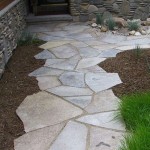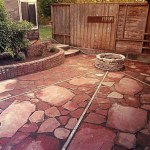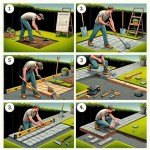Enhancing Your Patio With Pavers Over Concrete Slabs
The outdoor living space, particularly the patio, is an increasingly valued extension of the home. Homeowners are continually seeking ways to enhance the aesthetic appeal and functionality of these areas. One popular method for achieving this enhancement is the installation of pavers over existing concrete slabs. This approach offers a cost-effective means of transforming a plain or deteriorating concrete surface into a visually attractive and durable patio area. This article will explore the benefits of utilizing pavers over concrete, the installation process, and key considerations for ensuring a successful project.
Concrete slabs, while providing a solid foundation, can often be aesthetically uninspiring. Over time, concrete is susceptible to cracking, staining, and general wear and tear, leading to an unsightly patio surface. Replacing an entire concrete slab can be a costly and disruptive undertaking. Opting to install pavers over the existing concrete presents a more manageable and less expensive alternative. Pavers offer a wide array of design possibilities, allowing homeowners to customize the look and feel of their patio to match their personal preferences and the overall architectural style of their home.
Advantages of Pavers Over Concrete
Several advantages contribute to the popularity of using pavers over concrete slabs. These benefits encompass aesthetic improvements, practical advantages, and cost-effectiveness.
Aesthetic Appeal: Pavers are available in a vast range of colors, shapes, sizes, and textures, providing homeowners with almost limitless design options. This allows for the creation of unique and visually appealing patio surfaces. Unlike concrete, which is typically a uniform gray, pavers can be arranged in intricate patterns, adding depth and character to the outdoor space. The variety of materials, including brick, natural stone, and concrete, further expands the design possibilities. This aesthetic flexibility enables homeowners to create a patio that complements their home's architecture and landscaping.
Durability and Longevity: Pavers are manufactured to withstand heavy loads and extreme weather conditions. They are resistant to cracking, chipping, and fading, ensuring a long-lasting patio surface. The interlocking nature of pavers provides a stable and durable surface that can withstand the expansion and contraction caused by temperature fluctuations. In contrast to concrete, which can develop cracks over time, pavers are less prone to damage and require less maintenance in the long run. The individual nature of each paver means that if damage does occur, only the affected paver(s) needs to be replaced, minimizing repair costs and effort.
Cost-Effectiveness: Installing pavers over existing concrete is often more cost-effective than removing and replacing the entire concrete slab. The process eliminates the need for demolition and disposal, reducing labor and material costs. While the initial investment in pavers may be higher than a basic concrete surface, the long-term benefits, such as durability and low maintenance, can result in significant cost savings. Furthermore, the increased aesthetic appeal of a paver patio can enhance the property value, making it a worthwhile investment.
Improved Drainage: Pavers, when installed correctly, can improve drainage compared to a solid concrete slab. The joints between the pavers allow water to seep into the base, reducing the risk of pooling and runoff. This is particularly beneficial in areas with heavy rainfall. Proper installation, including a well-compacted base and appropriate grading, is crucial to ensure effective drainage and prevent water damage. Some paver systems are specifically designed to enhance permeability, further improving drainage capabilities.
Ease of Repair: As previously mentioned, individual pavers can be easily replaced if damaged, unlike a cracked concrete slab which often requires patching or complete replacement. This ease of repair minimizes disruption and cost associated with maintenance. The ability to replace individual pavers also allows for easy access to underground utilities if needed, without the need to break up large sections of concrete.
Installation Process: Preparing the Concrete Slab
Proper preparation of the existing concrete slab is crucial for ensuring the successful installation and longevity of the paver patio. This involves cleaning, leveling, and addressing any existing damage to the concrete surface.
Cleaning the Concrete: The first step is to thoroughly clean the concrete slab to remove any dirt, debris, oil stains, or other contaminants. This can be accomplished using a pressure washer and a suitable concrete cleaner. It is important to remove all loose materials and ensure a clean surface for the paver base to adhere to. Stubborn stains may require specialized cleaning solutions or scrubbing.
Assessing and Repairing Damage: Carefully inspect the concrete slab for cracks, chips, or other damage. Minor cracks can be filled with a concrete crack filler. Larger cracks or areas of significant damage may require more extensive repairs, such as patching with a concrete patching compound. It is important to address any structural issues before proceeding with the paver installation. Failure to repair underlying damage can compromise the stability and longevity of the paver patio.
Leveling the Surface: Ensuring a level surface is essential for a professional-looking paver patio. Use a long level to identify any uneven areas or depressions in the concrete slab. Fill these areas with a self-leveling concrete compound to create a smooth and even surface. It is crucial to follow the manufacturer's instructions carefully when applying the self-leveling compound. Allow the compound to dry completely before proceeding to the next step.
Installing Edge Restraints: Edge restraints are essential for preventing the pavers from shifting or spreading over time. These restraints can be made of plastic, metal, or concrete and are typically installed around the perimeter of the patio. Secure the edge restraints to the concrete slab using concrete screws or adhesive. Ensure that the edge restraints are properly aligned and provide a firm boundary for the pavers.
Installing the Pavers
Once the concrete slab is properly prepared, the installation of the pavers can begin. This involves creating a paver base, laying the pavers in the desired pattern, and filling the joints between the pavers.
Creating the Paver Base: A crucial step in the installation process is the creation of a paver base. This usually involves laying a layer of sand or crushed stone over the prepared concrete slab. The base provides a level surface for the pavers and helps to distribute weight evenly. A layer of geotextile fabric is often placed between the concrete slab and the paver base to prevent the base material from migrating into the concrete. The thickness of the paver base will depend on the size and type of pavers being used, as well as the expected load on the patio.
Laying the Pavers: Begin laying the pavers in the desired pattern, starting from one corner of the patio. Use a rubber mallet to gently tap each paver into place, ensuring that it is level and aligned with the adjacent pavers. Maintain consistent spacing between the pavers to create uniform joints. Use a paver cutter or saw to cut pavers as needed to fit around edges or obstacles. The chosen pattern will significantly impact the aesthetic appeal of the patio, and careful planning and execution are essential.
Filling the Joints: After the pavers are laid, fill the joints between the pavers with sand or polymeric sand. Sand provides a traditional look and allows for some flexibility in the paver surface. Polymeric sand is a mixture of sand and polymers that hardens when moistened, providing a more stable and durable joint. Sweep the sand or polymeric sand across the paver surface, ensuring that all the joints are completely filled. Use a broom to remove any excess material from the paver surface. Water the polymeric sand according to the manufacturer’s instructions to activate the hardening process.
Compacting the Pavers: After filling the joints, use a plate compactor to compact the paver surface. This will help to settle the pavers and ensure a stable and even surface. Compaction is particularly important when using sand as the joint filler, as it helps to lock the pavers together and prevent shifting. Be sure to use a protective mat under the plate compactor to prevent scratching or damaging the paver surface.
Sealing the Pavers (Optional): Sealing the pavers is optional, but it can help to protect the paver surface from staining and fading. A paver sealer can also enhance the color and shine of the pavers. Apply the sealer according to the manufacturer's instructions. Be sure to clean the paver surface thoroughly before applying the sealer.
By carefully following these steps, homeowners can successfully enhance their patio with pavers over existing concrete slabs, creating a beautiful and functional outdoor living space.

How To Install Pavers Over A Concrete Patio Family Handyman

How To Install Patio Pavers Over An Existing Concrete Slab

How To Lay A Patio On Concrete Or Over Paving Marshalls

Can You Put Pavers Over Concrete And Is It A Good Idea

How To Install Patio Pavers Over An Existing Concrete Slab

How To Install Patio Pavers Over An Existing Concrete Slab

Can You Overlay Paver Stones Over A Concrete Slab
I Have A Large Spot In The Backyard D Like To Turn Into Patio Maybe 18 By 12 Feet Would It Be Er Longer Lasting Concrete Poured Or Use

How To Lay A Patio Paving Slabs Step By Checkatrade

6 Concrete Patio Ideas To Boost The Appeal Of That Drab Slab
Related Posts








